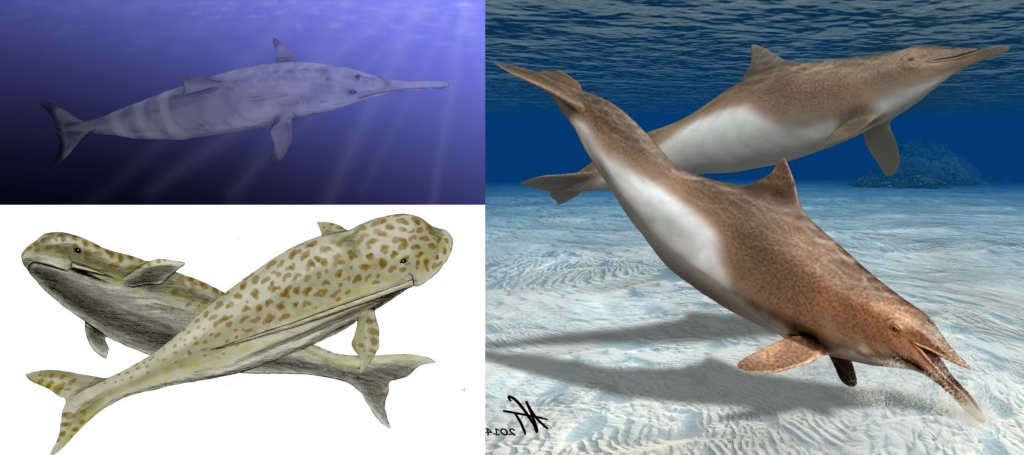Listen to Episode 172 on PodBean, YouTube, Spotify, or wherever you listen to your favorite podcasts!
The world’s most famous marine mammals come in two varieties. This episode, we discuss the diversity and evolutionary history of the more diverse of the two: Toothed Whales.
In the news
Microscopic fossils provide the earliest evidence for leaf-eating birds
Meet Tutcetus, the smallest known basilosaurid whale
Early marine reptile might have been a whale-like filter feeder
Huge fossils hint at one of the largest whales of all time
Whales with Teeth
Whales evolved from terrestrial ancestors during the Eocene, and quickly gave rise to a diversity of aquatic species. During the Oligocene, these early whales gave rise to two prominent groups: baleen whales (Mysticetes) and toothed whales (Odontocetes). Today, toothed whales include over 70 species of dolphins, porpoises, beluga whales, narwhals, beaked whales, and sperm whales.

Top: Sperm whale. Image by Gabriel Barathieu, CC BY-SA 2.0
Middle left: Orca. Image by Robert Pittman
Middle right: Common bottlenose dolphin. Image from NASA
Bottom left: Beluga. Image from premier.gov.ru, CC BY 4.0
Bottom left: Amazon river dolphin. Image by Oceancetaceen, CC BY-SA 2.0 DE
Unlike their baleen cousins, toothed whales typically have teeth. These teeth are usually simple, peg-like structures, although some species have evolved specialized tooth shapes. Toothed whales also tend to be much smaller on average than baleen whales, with most species being dolphin- or porpoise-sized, although there are notable exceptions. Toothed whales are also famous for their ability to echolocate, made possible by specialized structures in their skulls.

Left: Skull of a strap-toothed whale. Image by Nkansahrexford, CC BY 4.0
Right: Skull of a narwhal. Image by Pcornill, CC BY-SA 4.0
During the Oligocene, over 20 million years ago, the oceans were home to a number of extinct families of early toothed whales or close cousins. These included Simocetidae, Squalodontidae, and Xenorophidae, for example. More familiar families appeared later on, with many well-known toothed whales from the Miocene and later.

Top left: Squalodon, the “shark-toothed” whales. Image by Nobu Tamura, CC BY 3.0
Bottom left: Odobenocetops, the “walrus whale.” Image by Nobu Tamura, CC BY 3.0
Right: Semirostrum, an ancient porpoise with a weirdly long lower jaw. Image by Nobu Tamura, CC BY-SA 4.0
Many fossil toothed whales looked and probably lived a lot like modern dolphins and porpoises. There are exceptions, however, such as the impressive macroraptorial sperm whales of the Miocene, the bizarre Odobenocetops which had walrus-like tusks, and a surprising variety of long-snouted species related to modern river dolphins.

Top: Acrophyseter. Image by Olivier Lambert, CC BY-SA 3.0
Bottom: Livyatan. Image by Ghedoghedo, CC BY-SA 4.0
Dive Deeper
Macroraptorial sperm whales
Oligocene dolphin with tusk-like teeth
The awkward record of fossil whales (technical, open access)
The shape of cetacean skulls through deep time (technical, open access)
The origins of the killer whale ecomorph (technical, open access)
Macroraptorial sperm whales from the Miocene of Peru (technical, open access)
Encyclopedia of Marine Mammals (paywall)
__
If you enjoyed this topic and want more like it, check out these related episodes:
- Episode 41 – The Evolution of Whales
- Episode 51 – Mosasaurs
- Episode 59 – Bats
- Episode 171 – The Tethys Sea
We also invite you to follow us on Twitter, Facebook, or Instagram, buy merch at our Zazzle store, join our Discord server, or consider supporting us with a one-time PayPal donation or on Patreon to get bonus recordings and other goodies!
Please feel free to contact us with comments, questions, or topic suggestions, and to rate and review us on iTunes.